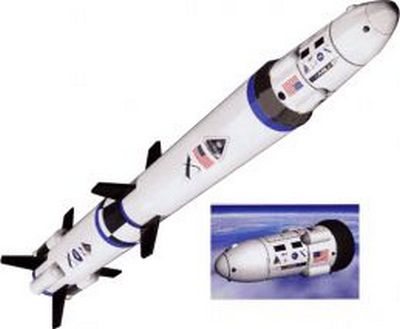| Construction Rating: | starstarstarstarstar_border |
| Flight Rating: | starstarstarstarstar_border |
| Overall Rating: | starstarstarstarstar_border |
| Diameter: | 1.64 inches |
| Manufacturer: | Estes  |
| Skill Level: | 1 |
| Style: | Scale |
 Brief:
Brief:
Single stage scale model of the Vanguard Eagle spacecraft for the X-Prize competition. I don't think the real one got off the ground.
Construction:
The kit came in a plastic bag with a cardboard face card as with every other Estes kit. It contained:
- 2 plastic nose cone halves
- clay nose weight
- 1 decal sheet
- 1 12" chute
- 1 rubber shock cord
- 1 long BT-55 body tube
- 1 sheet of small balsa fins
- 1 transition
- 1 short BT-60 body tube
- 1 launch lug
- 4 plastic fin quarters
- 2 plastic centering rings
- 1 BT-20 Engine tube
- 8 plastic display nozzles
- 1 engine hook (18mm)
- plastic disc to attach 4 of the 8 display nozzles
- instructions
The instructions were typical Estes and very clear. It provided many illustrations and were easy to follow and the steps were in a good order.
The ease of build should definitely be a skill level 2 instead of 1, mostly because of the plastic parts. The nose cone was easy to build, just insert the clay and CA the parts together. The transition and fin can, however, took forever to dry. I found the fin can to be kind of difficult to assemble.
For the fin can, you first have to assemble the motor mount by poking the engine hook through the BT-20 body tube. Then gluing the 2 centering rings with plastic cement to the engine tube ends. Next you have to cement the 4 fin halves together which again took forever to dry. Finally, use plastic cement to adhere the whole fin can into the short BT-60 body tube. Not a good idea for an impatient guy like me.
The only supplies needed are some cement for wood and plastic, scissors, regular glue, and sand paper.
Finishing:
Spray paint the whole rocket gloss white then paint the fins gloss black. The last step is to apply the peel 'n' stick decals like the face card. I didn't clear coat the rocket nor used sanding sealer because I'm very impatient.
Construction Rating: 4 out of 5
Flight:
I have flown it only once on a C6-3. The other recommended engines are: B4-2, B6-4, C6-3, C6-5. You need to insert about 4 sheets of wadding and pack a 12" parachute.
Flight 1 it took off pretty slow but went very high. It ejected about 2 seconds after apogee.
Recovery:
The Eagle uses a 12" parachute. Estes has brought back the checkerboard parachutes and rubber shock cords of the old days. The Eagle came down pretty fast and I even lost one of the plastic display nozzles on landing.
Flight Rating: 4 out of 5
Summary:
This isn't really a bad rocket, but some things could definitely be improved like the fin issue and maybe a larger parachute.
PROs: Great flier.
CONs: Assembly of the fins and the small parachute.
Overall Rating: 4 out of 5
Other Reviews
- Estes X-Prize Eagle By John R. Brandon III
Brief: Another fine single stage scale model of an Ansari X-Prize competitor from Estes. Construction: The kit parts included a BT-55 body tube, a BT-60 body tube, a BT-20 motor mount tube, a wire motor-retainer hook, a mylar ring to retain the motor hook, a block of clay nose weight, a launch lug, a preassembled 12" parachute, a heavy 1/4" x 30" rubber shock cord, a ...
 |
 |
Flights
 |
 |